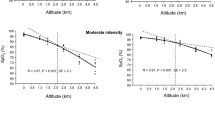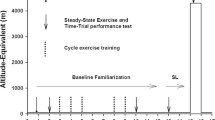Abstract
It has been hypothesized that one reason for decreased \(\dot V\hbox{O}_{2\max}\) in hypoxia could be the lower maximal exercise intensity achieved in incremental, time or distance trial tests. We hypothesized that (1) \(\dot V\hbox{O}_{2\max}\) would be decreased at altitude even when exercising at the same absolute maximal exercise intensity as at sea level and; (2) the decline in \(\dot V\hbox{O}_{2\max}\) in endurance-trained athletes (ETA) would be linear across the range from sea level through moderate altitudes. Eight ETA performed combined \(\dot V\hbox{O}_{2\max}\) and performance tests running to exhaustion at the same speed in a randomized double blind fashion at simulated altitudes of 300, 800, 1,300, 1,800, 2,300 and 2,800 m above sea level using a hypobaric chamber. Douglas bag system was used for respiratory measurements and pulse oximetry was used to estimate arterial O2 saturation. \(\dot V\hbox{O}_{2\max}\) declined linearly from 66±1.6 ml kg−1 min−1 at 300 m to 55±1.6 ml kg−1 min−1 at 2,800 m corresponding to a 6.3% decrease per 1,000 m increasing altitude (range 4.6–7.5%). Time to exhaustion (performance) at a constant velocity associated with 107% of sea level \(\dot V\hbox{O}_{2\max}\) decreased with 14.5% (P<0.001) per 1,000 m altitude between 300 and 2,800 m. Both \(\dot V\hbox{O}_{2\max}\) and performance decreased from 300 to 800 m (P<0.01; P<0.05). Arterial haemoglobin oxygen saturation at test cessation (SpO2min) declined from 89.0±2.9% at 300 m to 76.5±4.0% at 2,800 m (P=0.001). This study report that in ETA during acute exposure to altitude both performance and \(\dot V\hbox{O}_{2\max}\) decline from 300 to 800 m above sea level and continued to decrease linearly to 2,800 m.








Similar content being viewed by others
References
Billat VL, Lepretre PM, Heubert RP, Koralsztein JP, Gazeau FP (2003) Influence of acute moderate hypoxia on time to exhaustion at vVO2max in unacclimatized runners. Int J Sport Med 24:9–14
Buskirk ER, Kollias J, Akers RF, Prokop EK, Reategui EP (1967) Maximal performance at altitude and on return from altitude in conditioned runners. J Appl Physiol 23:259–266
Calbet JA, Boushel R, Radegran G, Sondergaard H, Wagner PD, Saltin B (2003) Determinants of maximal oxygen uptake in severe acute hypoxia. Am J Physiol Regul Integr Comp Physiol 284:R291–R303
Chapman RF, Emery M, Stager JM (1999) Degree of arterial desaturation in normoxia influences VO2max decline in mild hypoxia. Med Sci Sport Exerc 31:658–663
Ferretti G, Moia C, Thomet JM, Kayser B (1997) The decrease of maximal oxygen consumption during hypoxia in man: a mirror image of the oxygen equilibrium curve. J Physiol 498(Pt 1):231–237
Friedmann F, Bauer T, Menold E, Bartsch P (2004) Exercise with the intensity of the individual anaerobic threshold in acute hypoxia. Med Sci Sport Exerc 36:1737–1742
Fulco CS, Lewis SF, Frykman PN, Boushel R, Smith S, Harman EA, Cymerman A, Pandolf KB (1996) Muscle fatigue and exhaustion during dynamic leg exercise in normoxia and hypobaric hypoxia. J Appl Physiol 81:1891–1900
Fulco CS, Rock PB, Cymerman A (1998) Maximal and submaximal exercise performance at altitude. Aviat Space Environ Med 69:793–801
Gavin TP, Derchak PA, Stager JM (1998) Ventilation’s role in the decline in VO2max and SaO2 in acute hypoxic exercise. Med Sci Sport Exerc 30:195–199
Gore CJ, Hahn AG, Scroop GC, Watson DB, Norton KI, Wood RJ, Campbell DP, Emonson DL (1996) Increased arterial desaturation in trained cyclists during maximal exercise at 580 m altitude. J Appl Physiol 80:2204–2210
Gore CJ, Little SC, Hahn AG, Scroop GC, Norton KI, Bourdon PC, Woolford SM, Buckley JD, Stanef T, Campbell DP, Watson DB, Emonson DL (1997) Reduced performance of male and female athletes at 580 m altitude. Eur J Appl Physiol Occup Physiol 75:136–143
Grover RF, Weil JV, Reeves JT (1986) Cardiovascular adaptation to exercise at high altitude. Exerc Sport Sci Rev 14:269–302
Harms CA, Stager JM (1995) Low chemoresponsiveness and inadequate hyperventilation contribute to exercise-induced hypoxemia. J Appl Physiol 79:575–580
Ibanez J, Rama R, Riera M, Prats MT, Palacios L (1993) Severe hypoxia decreases oxygen uptake relative to intensity during submaximal graded exercise. Eur J Appl Physiol Occup Physiol 67:7–13
Knuttgen HG, Saltin B (1973) Oxygen uptake, muscle high-energy phosphates, and lactate in exercise under acute hypoxic conditions in man. Acta Physiol Scand 87:368–376
Koistinen P, Takala T, Martikkala V, Leppaluoto J (1995) Aerobic fitness influences the response of maximal oxygen uptake and lactate threshold in acute hypobaric hypoxia. Int J Sport Med 16:78–81
Lawler J, Powers SK, Thompson D (1988) Linear relationship between VO2max and VO2max decrement during exposure to acute hypoxia. J Appl Physiol 64:1486–1492
Manohar M, Goetz TE, Hassan AS (2004) NaHCO3 does not affect arterial O2 tension but attenuates desaturation of hemoglobin in maximally exercising thoroughbreds. J Appl Physiol 96: 1349–1356
Nielsen HB, Bredmose PP, Stromstad M, Volianitis S, Quistorff B, Secher NH (2002) Bicarbonate attenuates arterial desaturation during maximal exercise in humans. J Appl Physiol 93:724–731
Noakes TD, Peltonen JE, Rusko HK (2001) Evidence that a central governor regulates exercise performance during acute hypoxia and hyperoxia. J Exp Biol 204:3225–3234
Paterson DJ, Pinnington H, Pearce AR, Morton AR (1987) Maximal exercise cardiorespiratory responses of men and women during acute exposure to hypoxia. Aviat Space Environ Med 58:243–247
Peltonen JE, Rantamaki J, Niittymaki SP, Sweins K, Viitasalo JT, Rusko HK (1995) Effects of oxygen fraction in inspired air on rowing performance. Med Sci Sport Exerc 27:573–579
Peltonen JE, Leppavuori AP, Kyro KP, Makela P, Rusko HK (1999) Arterial haemoglobin oxygen saturation is affected by F(I)O2 at submaximal running velocities in elite athletes. Scand J Med Sci Sport 9:265–271
Peltonen JE, Tikkanen HO, Rusko HK (2001) Cardiorespiratory responses to exercise in acute hypoxia, hyperoxia and normoxia. Eur J Appl Physiol 85:82–88
Powers SK, Dodd S, Lawler J, Landry G, Kirtley M, McKnight T, Grinton S (1988) Incidence of exercise induced hypoxemia in elite endurance athletes at sea level. Eur J Appl Physiol Occup Physiol 58:298–302
Powers SK, Lawler J, Dempsey JA, Dodd S, Landry G (1989) Effects of incomplete pulmonary gas exchange on VO2max. J Appl Physiol 66:2491–2495
Robergs RA, Quintana R, Parker DL, Frankel CC (1998) Multiple variables explain the variability in the decrement in VO2max during acute hypobaric hypoxia. Med Sci Sport Exerc 30:869–879
Rowell LB, Blackmon JR (1987) Human cardiovascular adjustments to acute hypoxaemia. Clin Physiol 7:349–376
Squires RW, Buskirk ER (1982) Aerobic capacity during acute exposure to simulated altitude, 914 to 2286 meters. Med Sci Sport Exerc 14:36–40
Terrados N, Mizuno M, Andersen H (1985) Reduction in maximal oxygen uptake at low altitudes; role of training status and lung function. Clin Physiol 5(Suppl 3):75–79
Warren GL, Cureton KJ, Middendorf WF, Ray CA, Warren JA (1991) Red blood cell pulmonary capillary transit time during exercise in athletes. Med Sci Sport Exerc 23:1353–1361
Acknowledgements
We acknowledge Jan Erlend Hem and Svein Leirstein for excellent technical assistance during the experiments.
Author information
Authors and Affiliations
Corresponding author
Rights and permissions
About this article
Cite this article
Wehrlin, J.P., Hallén, J. Linear decrease in \(\dot V\hbox{O}_{2\max}\) and performance with increasing altitude in endurance athletes. Eur J Appl Physiol 96, 404–412 (2006). https://doi.org/10.1007/s00421-005-0081-9
Accepted:
Published:
Issue Date:
DOI: https://doi.org/10.1007/s00421-005-0081-9




